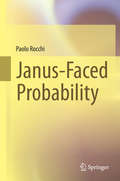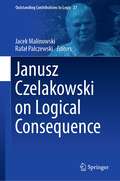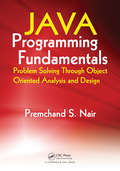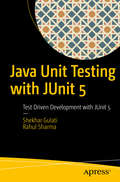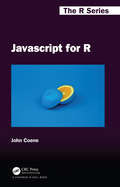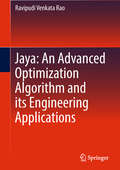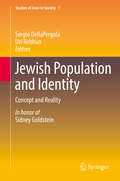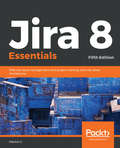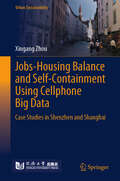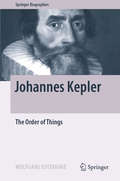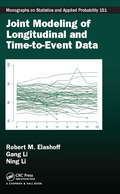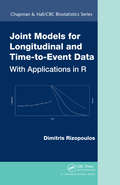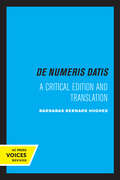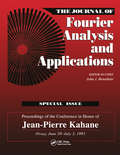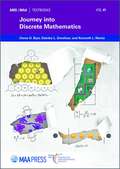- Table View
- List View
Janus-Faced Probability
by Paolo RocchiThe problem of probability interpretation was long overlooked before exploding in the 20th century, when the frequentist and subjectivist schools formalized two conflicting conceptions of probability. Beyond the radical followers of the two schools, a circle of pluralist thinkers tends to reconcile the opposing concepts The author uses two theorems in order to prove that the various interpretations of probability do come into opposition and can be used in different contexts. The goal here is to clarify the multi fold nature of probability by means of a purely mathematical approach and to show how philosophical arguments can only serve to deepen actual intellectual contrasts. The book can be considered as one of the most important contributions in the analysis of probability interpretation in the last 10-15 years.
Janusz Czelakowski on Logical Consequence (Outstanding Contributions to Logic #27)
by Jacek Malinowski Rafał PalczewskiThis book is dedicated to the life and work of logician Janusz Czelakowski on the topic of logical consequence. It consists of three parts – a biography, a survey and research sections. The volume begins with an autobiographic chapter by Janusz Czelakowski followed by a historical chapter written by Jacek Malinowski. The survey section forms the backbone of the volume with each chapter covering one of Janusz Czelakowski’s results. They focus on his results in the area of logical consequence, demonstrate how his results influenced following research, and presents potential future results, problems and applications. This volume is of interest to logicians and mathematicians.
Japanese Abacus Use & Theory
by Takashi KojimaThe Japanese Abacus & Theory book is easy to follow, and gives the reader step-by-step directions on how to use it correctly while applying it to practical use. The imperfect numerical notation and scarcity of suitable writing materials in ancient times are presumed to have given rise to need for devices of mechanical calculation. While the definite origin of the abacus is obscure, there is some reason for believing that its earliest form reckoning table covered with sand or fine dust, in which figures were drawn with a stylus, to be erased with the figure when necessary. Though the Abacus is an older tool for calculation it still is used today in Japan taking on a different name called Soroban. Though the Japanese Abacus or Soroban may appear mysterious or even primitive to those raised in the age of pocket calculators and desktop computers, this intriguing tool is capable of amazing speed and accuracy. It is still widely used throughout the shops and markets of Asia, and its popularity shows no sign of decline. Here for the first time in English is a complete explanation of how to use the abacus.
Japanese Population Geographies I: Migration, Urban Areas, and a New Concept (SpringerBriefs in Population Studies)
by Yoshitaka IshikawaThis is the first anthology that conveys in detail the actual situation of population geographies in Japan, a country facing some of the world's most serious demographic trends such as low fertility, population aging, and depopulation. The anthology consists of two volumes with the common title Japanese Population Geographies. All of the included entries are based on original Japanese papers written by leading geographers and published within the past few years, useful for understanding Japan’s current population geographies. The first volume analyzes the postwar transition of internal migration, examining the structural changes of population in urban areas, and proposes a new measure different from the traditional resident population. This volume also presents an investigation of the retirement migration of baby boomers as well as displacement migration due to the 2011 Great East Japan Earthquake. The second volume’s contents examine the residential choices of minority populations such as foreign residents and sexual minorities. It also discusses future prospects associated with mono-polar concentration into Tokyo, regional forecasting using population projections based on small-area units, and the importance of a politico–economic perspective in the future research. Taken as a whole, this anthology offers the following two significant contributions. First, the excellent achievements obtained in Japan, which is experiencing serious demographic trends, reflect key developments within the context of the world's population geography. The second contribution is that the book brings the latest insights and important policy implications to countries that are facing various issues associated with decreasing fertility, aging population, and declining population.
Japanese Population Geographies II: Minority Populations and Future Prospects (SpringerBriefs in Population Studies)
by Yoshitaka IshikawaThis is the first anthology that conveys in detail the actual situation of population geographies in Japan, a country facing some of the world's most serious demographic trends such as low fertility, population aging, and depopulation. The anthology consists of two volumes with the common title Japanese Population Geographies. All of the included entries are based on original Japanese papers written by leading geographers and published within the past few years, useful for understanding Japan’s current population geographies. The first volume analyzes the postwar transition of internal migration, examining the structural changes of population in urban areas, and proposes a new measure different from the traditional resident population. This volume also presents an investigation of the retirement migration of baby boomers as well as displacement migration due to the 2011 Great East Japan Earthquake. The second volume’s contents examine the residential choices of minority populations such as foreign residents and sexual minorities. It also discusses future prospects associated with mono-polar concentration into Tokyo, regional forecasting using population projections based on small-area units, and the importance of a politico–economic perspective in future research. Taken as a whole, this anthology offers the following two significant contributions. First, the excellent achievements obtained in Japan, which is experiencing serious demographic trends, reflect key developments within the context of the world's population geography. The second contribution is that the publication brings the latest insights and important policy implications to countries that are facing various issues associated with decreasing fertility, aging population, and declining population.
Japan’s Population Implosion
by Yoichi FunabashiThis cutting edge collection examines Japan's population issue, exploring how declining demographic trends are affecting Japan's social structure, specifically in the context of Greater Tokyo, life infrastructure, public finance and the economy. Considering the failures of past Japanese policies from the perspective of population, national land, and politics, it argues that the inability of past administrations to develop a long-term and comprehensive policy has exacerbated the population crisis. This text identifies key negative chain reactions that have stemmed from this policy failure, notably the effect of population decline on future economic growth and public finances and the impact of shrinking municipalities on social and community infrastructure to support quality of life. It also highlights how population decline can precipitate inter-generational conflict, and impact on the strength of the state and more widely on Japan's international status. Japan is on the forefront of the population problem, which is expected to affect many of the world's advanced industrial economies in the 21st century. Based on the study of policy failures, this book makes recommendations for effective population policy - covering both 'mitigation' measures to encourage a recovery in the depopulation process as well as 'adaptation' measures to maintain and improve living standards - and provides key insights into dealing with the debilitating effects of population decline.
Java Programming Fundamentals: Problem Solving Through Object Oriented Analysis and Design
by Premchand S. NairWhile Java texts are plentiful, it's difficult to find one that takes a real-world approach, and encourages novice programmers to build on their Java skills through practical exercise. Written by an expert with 19 experience teaching computer programming, Java Programming Fundamentals presents object-oriented programming by employing examples taken
Java Unit Testing with JUnit 5
by Shekhar Gulati Rahul SharmaExplore the new way of building and maintaining test cases with Java test driven development (TDD) using JUnit 5. This book doesn't just talk about the new concepts, it shows you ways of applying them in TDD and Java 8 to continuously deliver code that excels in all metrics. Unit testing and test driven development have now become part of every developer's skill set. For Java developers, the most popular testing tool has been JUnit, and JUnit 5 is built using the latest features of Java. With Java Unit Testing with JUnit 5, you'll master these new features, including method parameters, extensions, assertions and assumptions, and dynamic tests. You'll also see how to write clean tests with less code. This book is a departure from using older practices and presents new ways of performing tests, building assertions, and injecting dependencies. What You Will Learn Write tests the JUnit 5 way Run your tests from within your IDE Integrate tests with your build and static analysis tools Migrate from JUnit 4 to JUnit 5 Who This Book Is For Java developers both with and without any prior unit testing experience.
Javascript for R (Chapman & Hall/CRC The R Series)
by John CoeneLittle known to many, R works just as well with JavaScript—this book delves into the various ways both languages can work together. The ultimate aim of this work is to put the reader at ease with inviting JavaScript in their data science workflow. In that respect the book is not teaching one JavaScript but rather we show how little JavaScript can greatly support and enhance R code. Therefore, the focus is on integrating external JavaScript libraries and no prior knowledge of JavaScript is required. Key Features: ● Easy to pick up. ● An entry way to learning JavaScript for R. ● Covers topics not covered anywhere else. ● Easy to follow along.
Jaya: An Advanced Engineering Optimization Algorithm And Its Applications
by Ravipudi Venkata RaoThis book introduces readers to the “Jaya” algorithm, an advanced optimization technique that can be applied to many physical and engineering systems. It describes the algorithm, discusses its differences with other advanced optimization techniques, and examines the applications of versions of the algorithm in mechanical, thermal, manufacturing, electrical, computer, civil and structural engineering.In real complex optimization problems, the number of parameters to be optimized can be very large and their influence on the goal function can be very complicated and nonlinear in character. Such problems cannot be solved using classical methods and advanced optimization methods need to be applied. The Jaya algorithm is an algorithm-specific parameter-less algorithm that builds on other advanced optimization techniques. The application of Jaya in several engineering disciplines is critically assessed and its success compared with other complex optimization techniques such as Genetic Algorithms (GA), Particle Swarm Optimization (PSO), Differential Evolution (DE), Artificial Bee Colony (ABC), and other recently developed algorithms.
Jeremiah Shapes Up!
by Ella FontaineThe bell rings to end another day at school but for Jeremiah it is only the beginning of an outrageous adventure in shapes. Jeremiah Shapes Up! is a story that takes the young reader on an exploration of three-dimensional shapes by introducing them through the tantalizing world of narrative fiction. Children of all ages will make connections with important math concepts as they join Jeremiah on an exploration of geometric solids in the real world. It is an educational adventure that turns an ordinary day into an extraordinary one and leaves the reader in awe about the importance of numbers to the world.
Jewish Family: Identity And Self-Formation At Home (The Modern Jewish Experience)
by Alex Pomson Randal F. SchnoorIn Jewish Family: Identity and Self-Formation at Home Alex Pomson and Randal F. Schnoor advance a new appreciation for the deep significance of Jewish family in developing Jewish identity. This book is the result of ten years of research focused on a small sample of diverse families. Through their work, the authors paint an intricate picture of the ecosystem that the family unit provides for identity formation over the life course. They draw upon theories of family development as well as sociological theories of the transmission of social and cultural capital in their analysis of the research. They find that family networks, which are often intergenerational, are just as significant as cultural capital, such as knowledge and competence in Judaism, to the formation of Jewish identity. Pomson and Schnoor provide readers with a unique view into the complexity of being Jewish in North America today.
Jewish Population and Identity: Concept and Reality (Studies of Jews in Society #1)
by Uzi Rebhun Sergio DellaPergolaThis book examines the fundamentals of Jewish demography and sociology around the world. It is not only concerned with documenting patterns of population change but also with an intriguing and ever-present issue like "Who is a Jew?" The latter transcends the limits of quantitative assessment and deeply delves into the nature, boundaries, and quality of group identification. A growing challenge is how to bridge between concept – related to ideals and theory – and reality – reflecting field research. Divided into six sections, the book discusses historical demography, immigration and settlement, population dynamics, social stratification and economy, family and Jewish identity in the U.S., and Jewish identity in Israel. The volume represents the dynamic and diverse nature of the study of world and local Jewish populations. It shows how that field of study provides an important contribution to the broader and now rapidly expanding study of religious and ethnic groups. Scholars in disciplines such as history, geography, sociology, economics, political science, and especially demography follow and analyze the social and cultural patterns of Jews in different places around the globe, at various times, and from complementary perspectives. They make use of historical sources that have recently become accessible, utilize new censuses and surveys, and adopt advanced analytical methods. While some of their observations attest to consistency in the Jews’ demographic and identificational patterns, others evolve and ramify in new directions that reflect general processes in the areas and societies that Jews inhabit, internal changes within Jewish communities, and intergenerational trends in personal preferences of religious and ethnic orientations. This volume brings together contributions from scholars around the world and presents new and updated research and insights.
Jira 8 Essentials - Fifth Edition: Effective Issue Management And Project Tracking With The Latest Jira Features, 5th Edition
by Patrick LiThis book will be especially useful for project managers but it's also intended for other Jira users, including developers, and any other industry besides software development, who would like to leverage Jira's powerful task management and workflow features to better manage their business processes.
Jobs-Housing Balance and Self-Containment Using Cellphone Big Data: Case Studies in Shenzhen and Shanghai (Urban Sustainability)
by Xingang ZhouThis book addresses the analysis of self-containment of employment (SCE), which measures journey-to-work trips among the percentage of workers who work locally. High SCE encourages the use of non-motorized transport and reduces transport-related energy consumption. In this book, mobile phone location data is employed to assess journey-to-work trips and explore spatial variations in SCE at multiple geographic scales. It finds that SCE is significantly higher in the suburbs than that in the central urban areas and tends to decrease as the spatial analysis unit shifts from the macro to the micro scale. The relationship between Jobs–housing balance is found to be more important in self-containment of employment for secondary-sector workers compared with that for tertiary-sector workers. Secondary-sector workers tend to reside near their workplaces because of relatively balanced jobs and housing, whereas tertiary-sector workers tend to reside farther away from their workplaces to save housing cost. A mixed-use index (MUI) in terms of employment is examined. The interconnections between MUI and SCE are examined in both industrial and commercial areas, to gauge the effect of the industrial-residential mix or commercial-residential mix on SCE. This book will enhance readers’ understanding of the spatial variations in SCE at multiple scales. In addition, its investigation of the effect of mixed use on SCE will shed new light on the relationship between land use and journey-to-work patterns.
Johannes Kepler: The Order of Things (Springer Biographies)
by Wolfgang OsterhageThis book traces the development of Kepler’s ideas along with his unsteady wanderings in a world dominated by religious turmoil. Johannes Kepler, like Galileo, was a supporter of the Copernican heliocentric world model. From an early stage, his principal objective was to discover “the world behind the world”, i.e. to identify the underlying order and the secrets that make the world function as it does: the hidden world harmony. Kepler was driven both by his religious belief and Greek mysticism, which he found in ancient mathematics. His urge to find a construct encompassing the harmony of every possible aspect of the world – including astronomy, geometry and music – is seen as a manifestation of a deep human desire to bring order to the apparent chaos surrounding our existence. This desire continues to this day as we search for a theory that will finally unify and harmonise the forces of nature.
John Napier: Life, Logarithms, and Legacy
by Julian HavilThe most comprehensive account of the mathematician's life and workJohn Napier (1550–1617) is celebrated today as the man who invented logarithms—an enormous intellectual achievement that would soon lead to the development of their mechanical equivalent in the slide rule: the two would serve humanity as the principal means of calculation until the mid-1970s. Yet, despite Napier's pioneering efforts, his life and work have not attracted detailed modern scrutiny. John Napier is the first contemporary biography to take an in-depth look at the multiple facets of Napier’s story: his privileged position as the eighth Laird of Merchiston and the son of influential Scottish landowners; his reputation as a magician who dabbled in alchemy; his interest in agriculture; his involvement with a notorious outlaw; his staunch anti-Catholic beliefs; his interactions with such peers as Henry Briggs, Johannes Kepler, and Tycho Brahe; and, most notably, his estimable mathematical legacy.Julian Havil explores Napier’s original development of logarithms, the motivations for his approach, and the reasons behind certain adjustments to them. Napier’s inventive mathematical ideas also include formulas for solving spherical triangles, "Napier’s Bones" (a more basic but extremely popular alternative device for calculation), and the use of decimal notation for fractions and binary arithmetic. Havil also considers Napier’s study of the Book of Revelation, which led to his prediction of the Apocalypse in his first book, A Plaine Discovery of the Whole Revelation of St. John—the work for which Napier believed he would be most remembered.John Napier assesses one man’s life and the lasting influence of his advancements on the mathematical sciences and beyond.
Joint Modeling of Longitudinal and Time-to-Event Data (Chapman & Hall/CRC Monographs on Statistics and Applied Probability #151)
by Ning Li Robert Elashoff Gang liLongitudinal studies often incur several problems that challenge standard statistical methods for data analysis. These problems include non-ignorable missing data in longitudinal measurements of one or more response variables, informative observation times of longitudinal data, and survival analysis with intermittently measured time-dependent covariates that are subject to measurement error and/or substantial biological variation. Joint modeling of longitudinal and time-to-event data has emerged as a novel approach to handle these issues. Joint Modeling of Longitudinal and Time-to-Event Data provides a systematic introduction and review of state-of-the-art statistical methodology in this active research field. The methods are illustrated by real data examples from a wide range of clinical research topics. A collection of data sets and software for practical implementation of the joint modeling methodologies are available through the book website. This book serves as a reference book for scientific investigators who need to analyze longitudinal and/or survival data, as well as researchers developing methodology in this field. It may also be used as a textbook for a graduate level course in biostatistics or statistics.
Joint Models for Longitudinal and Time-to-Event Data: With Applications in R (Chapman & Hall/CRC Biostatistics Series #Vol. 6)
by Dimitris RizopoulosIn longitudinal studies it is often of interest to investigate how a marker that is repeatedly measured in time is associated with a time to an event of interest, e.g., prostate cancer studies where longitudinal PSA level measurements are collected in conjunction with the time-to-recurrence. Joint Models for Longitudinal and Time-to-Event Data: Wit
Jordanus de Nemore, de Numeris Datis: A Critical Edition and Translation (Center for Medieval and Renaissance Studies, UCLA #14)
by Jordanus De NemoreThis title is part of UC Press's Voices Revived program, which commemorates University of California Press’s mission to seek out and cultivate the brightest minds and give them voice, reach, and impact. Drawing on a backlist dating to 1893, Voices Revived makes high-quality, peer-reviewed scholarship accessible once again using print-on-demand technology. This title was originally published in 1981.
Jost Bürgi's Aritmetische und Geometrische Progreß Tabulen
by Kathleen ClarkThis monograph presents a groundbreaking scholarly treatment of the German mathematician Jost Bürgi's original work on logarithms, Arithmetische und Geometrische Progreß Tabulen. It provides the first-ever English translation of Bürgi's text and illuminates his role in the development of the conception of logarithms, for which John Napier is traditionally given priority. High-resolution scans of each page of the his handwritten text are reproduced for the reader and as a means of preserving an important work for which there are very few surviving copies. The book begins with a brief biography of Bürgi to familiarize readers with his life and work, as well as to offer an historical context in which to explore his contributions. The second chapter then describes the extant copies of the Arithmetische und Geometrische Progreß Tabulen, with a detailed description of the copy that is the focus of this book, the 1620 "Graz manuscript". A complete facsimile of the text is included in the next chapter, along with a corresponding transcription and an English translation; a transcription of a second version of the manuscript (the "Gdansk manuscript") is included alongside that of the Graz edition so that readers can easily and closely examine the differences between the two. The final chapter considers two important questions about Bürgi's work, such as who was the copyist of the Graz manuscript and what the relationship is between the Graz and Gdansk versions. Appendices are also included that contain a timeline of Bürgi's life, the underlying concept of Napier's construction of logarithms, and scans of all 58 sheets of the tables from Bürgi's text. Anyone with an appreciation for the history of mathematics will find this book to be an insightful and interesting look at an important and often overlooked work. It will also be a valuable resource for undergraduates taking courses in the history of mathematics, researchers of the history of mathematics, and professors of mathematics education who wish to incorporate historical context into their teaching.
Jost Functions in Quantum Mechanics: A Unified Approach to Scattering, Bound, and Resonant State Problems
by Sergei A. RakityanskyBased on Jost function theory this book presents an approach useful for different types of quantum mechanical problems. These include the description of scattering, bound, and resonant states, in a unified way. The reader finds here all that is known about Jost functions as well as what is needed to fill the gap between the pure mathematical theory and numerical calculations. Some of the topics covered are: quantum resonances, Regge poles, multichannel scattering, Coulomb interaction, Riemann surfaces, multichannel analog of the effective range theory, one- and two-dimensional problems, many-body problems within the hyperspherical approach, just to mention few of them. These topics are relevant in the fields of quantum few-body theory, nuclear reactions, atomic collisions, and low-dimensional semiconductor nanostructures. In light of this, the book is meant for students, who study quantum mechanics, scattering theory, or nuclear reactions at the advanced level as well as for post-graduate students and researchers in the fields of nuclear and atomic physics. Many of the arguments that are traditional for textbooks on quantum mechanics and scattering theory, are covered here in a different way, using the Jost functions. This gives the reader a new insight into the subject, revealing new features of various mathematical objects and quantum phenomena.
Journal of Fourier Analysis and Applications Special Issue
by John J. BenedettoThe Journal of Fourier Analysis and Applications is a journal of the mathematical sciences devoted to Fourier analysis and its applications. The subject of Fourier analysis has had a major impact on the development of mathematics, on the understanding of many engineering and scientific phenomena, and on the solution of some of the most important problems in mathematics and the sciences. At the end of June 1993, a large Conference in Harmonic Analysis was held at the University of Paris-Sud at Orsay to celebrate the prominent role played by Jean-Pierre Kahane and his numerous achievements in this field. The large variety of topics discussed in this meeting, ranging from classical Harmonic Analysis to Probability Theory, reflects the intense mathematical curiosity and the broad mathematical interest of Jean-Pierre Kahane. Indeed, all of them are connected to his work. The mornings were devoted to plenary addresses while up to four parallel sessions took place in the afternoons. Altogether, there were about eighty speakers. This wide range of subjects appears in these proceedings which include thirty six articles.
Journal of Political Economy vol 128 no 9 (September 2020)
by The University of Chicago PressJournal of Political Economy vol 128 no 9 (September 2020)
Journey Into Discrete Mathematics (AMS/MAA Textbooks #41)
by Owen Byer Deirdre Smeltzer Kenneth WantzJourney into Discrete Mathematics is designed for use in a first course in mathematical abstraction for early-career undergraduate mathematics majors. The important ideas of discrete mathematics are included logic, sets, proof writing, relations, counting, number theory, and graph theory in a manner that promotes development of a mathematical mindset and prepares students for further study. While the treatment is designed to prepare the student reader for the mathematics major, the book remains attractive and appealing to students of computer science and other problem-solving disciplines. The exposition is exquisite and engaging and features detailed descriptions of the thought processes that one might follow to attack the problems of mathematics. The problems are appealing and vary widely in depth and difficulty. Careful design of the book helps the student reader learn to think like a mathematician through the exposition and the problems provided. Several of the core topics, including counting, number theory, and graph theory, are visited twice: once in an introductory manner and then again in a later chapter with more advanced concepts and with a deeper perspective. Owen D. Byer and Deirdre L. Smeltzer are both Professors of Mathematics at Eastern Mennonite University. Kenneth L. Wantz is Professor of Mathematics at Regent University. Collectively the authors have specialized expertise and research publications ranging widely over discrete mathematics and have over fifty semesters of combined experience in teaching this subject.
